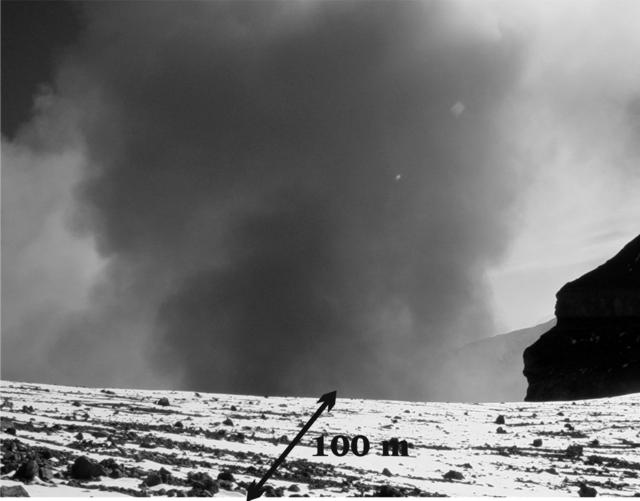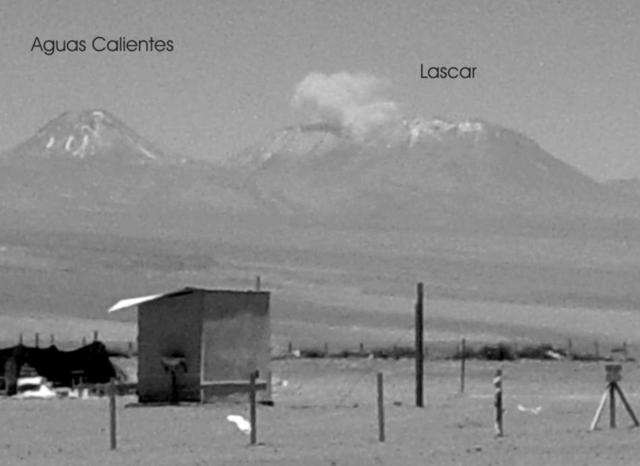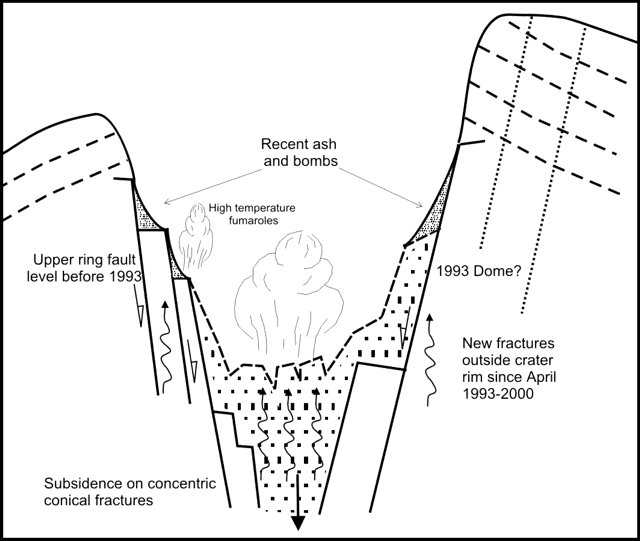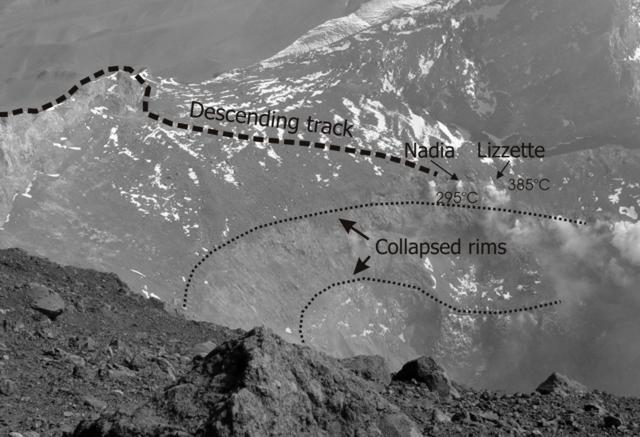Report on Lascar (Chile) — March 2003
Bulletin of the Global Volcanism Network, vol. 28, no. 3 (March 2003)
Managing Editor: Edward Venzke.
Lascar (Chile) Small ash eruptions in October 2002; fumarole investigations
Please cite this report as:
Global Volcanism Program, 2003. Report on Lascar (Chile) (Venzke, E., ed.). Bulletin of the Global Volcanism Network, 28:3. Smithsonian Institution. https://doi.org/10.5479/si.GVP.BGVN200303-355100
Lascar
Chile
23.37°S, 67.73°W; summit elev. 5592 m
All times are local (unless otherwise noted)
An international team of scientists conducted an interdisciplinary research project at Lascar from 13 October 2002 to15 January 2003. The group of scientists from Argentina, Chile, Italy, Puerto Rico, United Kingdom, and the United States, includes volcanologists who have directly observed the volcano from before the 1993 eruption (BGVN 18:04). During the first part of the project the team took the first ever direct measurements of fumarole temperatures and gas compositions within the crater, which are to be compared with measurements acquired through remote sensing techniques. The combination of direct and ground- and satellite-based measurements at very different spatial scales will hopefully corroborate results from the different techniques. A significant change in crater geometry over the last few years was identified through comparison with work carried out by Gardeweg and others (1993) and Matthews and others (1997).
Visual observations. On 26 October 2002 small explosive eruptive events (reaching heights of 300 m above the crater) were observed at 0905, 0910, and 0915 by both the remote-sensing team 7 km SE of the vent and the direct sampling team on the crater rim (figure 25). Winds from the NW rapidly dispersed the ash cloud. On 27 October at 0845, loud noises were heard, and an ash plume was observed by people 7 km NW of the volcano. At 1340 a much more vigorous explosion produced a plume that rose at least 1,500 m above the vent (figure 26), which was observed by the volcanologists from Pozo Tres, 60 km NW.
 |
Figure 25. Photograph of an ash eruption at Lascar on 26 October 2002 seen from the crater rim. Courtesy of Franco Tassi. |
 |
Figure 26. Photograph of an eruption at Lascar on 27 October 2002 seen from "Pozo Tres." Courtesy of J.G. Viramonte. |
On 1 November 2002 the direct-measurement team reached the crater for a second time to collect gas samples. Comparison with previous descriptions (Gardeweg and others, 1993; Matthews and others, 1997) and photographs taken by J.G. Viramonte at the beginning of the 1990's indicated that after the 2000 eruption (BGVN 25:06; http://www.unsa.edu.ar/varias/lascar; http://www. conae.gov.ar) several changes in crater morphology and locations of the high-flux fumaroles occurred. The dome had collapsed by several tens of meters, producing a deep, steep, hole ~200 m in diameter and 200 m deep, with a number of large fumaroles around the internal rim and at the base (figure 27). Observations suggest that Lascar is presently at or near the climax of the "dome subsidence phase," as described by Matthews and others (1997). There was no evidence of new dome emplacement after the July 2000 eruption.
 |
Figure 27. Cross-section sketch of the Lascar crater showing fractures, high-temperature fumaroles, and areas of recent ash and bombs. Courtesy of J.G. Viramonte. |
Direct techniques. Team members from Universita' degli Studi di Firenze (Italy), Universidad Nacional de Salta (Argentina), and Universidad Catolica del Norte (Chile) took, for the first time, direct temperature measurements of Lascar's fumaroles and collected gas samples using vacuum bottles filled with a 4N NaOH + 0.15N CdOH solution (Montegrossi and others, 2001). Sampled fumaroles were aligned along the upper collapse ring fault in the NW internal flank of the active crater (figure 28). A maximum temperature of 385°C was measured. Preliminary results indicate a very high concentration of acidic gases, with a paucity of water vapor. A more complete analysis, performed by gas chromatography and mass spectrometry, will be done in the Department of Earth Sciences at the Univ. Firenze.
 |
Figure 28. Photograph of the NW side of the Lascar crater, modified to show the collapsed rims and fumarole sampling locations in October 2002. Courtesy of Franco Tassi. |
Remote-sensing techniques. Team members from Michigan Technological University (MTU), Cambridge, and Universidad Nacional de Salta (UNSa) provided a suite of state-of-the-art ground-based instruments, including a miniature UV spectrometer that utilizes Differential Optical Absorption Spectroscopy (DOAS), a MICROTOPS II sun-photometer, and a Kestrel 4000 weather station. The instruments will help provide a more complete understanding of S-bearing species, and their fates in a high, dry atmosphere. The mini UV spectrometer provides an open path line-of-site burden of SO2 through spectral analysis (Galle and others, 2002; Edmonds and others, 2002), which can be used to derive SO2 emission rates (using the plume's speed and width). The sun-photometer will provide information about the plume's liquid- and solid-phase species, specifically sulfate aerosol. The aerosol's spectral signature can be used to derive the particle size distribution from the spectral optical depth (Watson and Oppenheimer, 2000). The weather station, in conjunction with the other instruments, will elucidate the effects of Lascar's high, dry, and extremely transmissive atmosphere upon SO2 conversion rates. The team will also derive SO2 burdens and emission rates using satellite imagery from NASA's ASTER (Advanced Spaceborne Thermal Emission and Reflection Radiometer) sensor.
Lascar provides an opportunity to study the effects of an end-member atmosphere upon volcanic plumes with the aim of better understanding the fates of volcanic species in the high troposphere (and hence the lower stratosphere). The DOAS is an exciting new instrument, first applied to volcanic studies by volcanologists from the Montserrat Volcano Observatory (MVO), Cambridge University (UK), and Chalmer's University of Technology (Sweden) that is now rapidly replacing the older, bulkier, and much more expensive correlation spectrometer (COSPEC). This experiment is a continuation of that work in a new and different environment.
Future work. The Cambridge team planned to begin a new round of remote studies in early 2003, using the DOAS system and sun-photometers, in particular to investigate evolution of the aerosol phase of the plume. The direct gas sampling by the Florence, Salta, and Del Norte team will be repeated, hopefully in 2003. The group, led by the MTU and UNSa contingent, plan to use recently acquired ASTER data to investigate SO2 emission. Hotspot activity will be studied using ASTER, MODIS, and GOES data. A study of the morphological evolution of the crater is planned for the near future, hopefully incorporating previous investigators' work on cyclic activity at Lascar.
References. Déruelle, B., Medina, E.T., Figueroa, O.A., Maragaño, M.C., and Viramonte, J.G., 1995, The recent eruption of Lascar volcano (Atacama-Chile, April 1993): petrological and volcanological relationships: C.R. Acad. Sci. Paris, 321, série II, p. 377-384.
Déruelle, B., Figueroa, O.A., Medina, E.T., Viramonte, J.G., and Maragaño, M.C., 1996, Petrology of pumices of April 1993 eruption of Lascar (Atacama, Chile): Blackwell Science Ltd, Terra Nova, v. 8, p. 191-199.
Edmonds, M., Herd, R.A., Galle, B., and Oppenheimer, C.M., 2002, Automated, high time resolution measurements of SO2 flux at Soufriere Hills Volcano, Montserrat: in review.
Galle, B., Oppenheimer, C., Geyer, A., McGonigle, A., Edmonds, M., and Horrocks, L.A., 2002, A miniaturised ultraviolet spectrometer for remote sensing of SO2 fluxes: a new tool for volcano surveillance: Journal of Volcanology and Geothermal Research, v. 119, p. 241-254.
Gardeweg, M.C., Sparks, S., Matthews, S., Fuentealba, C., Murillo, M., and Espinoza, A., 1993, V informe sobre el comportamiento del volcan Lascar (II región): Enero-Marzo 1993: SERNAGEOMIN, Chile, Marzo 1993.
Gardeweg, M.C., and Medina, E., 1994, La erupción subpliniana del 19-20 de Abril del volcan Lascar N de Chile: Congreso Geológico Chileno, Actas I, p. 299-304.
Matthews, S.J., Gardeweg, M.C., and Sparks, R.S.J., 1997, The 1984 to 1996 cyclic activity of Lascar Volcano, northern Chile: cycles of dome growth, dome subsidence, degassing and explosive eruptions: Bulletin of Volcanology, v. 59, p. 72-82.
Montegrossi, G., Tassi, F., Vaselli, O., Buccianti, A., and Garofalo, K., 2001, Sulphur species in volcanic gases: Anal. Chem., v. 73, p. 3,709-3,715.
Viramonte, J.G., Seggiaro, R.E., Becchio, R.A., and Petrinovic, I.A., 1994, Erupción del Volcán Lascar, Chile, Andes Centrales, Abril de 1993: 4ta Reunión Internacional del Volcán de Colima, Colima, México, Actas I, p. 149-151.
Watson, I.M., and Oppenheimer, C., 2000, Particle size distributions of Mt. Etna's aerosol plume constrained by sunphotometry: Journal of Geophysical Research, Atmospheres, v. 105, no. D8, p. 9,823-9,829.
Geological Summary. Láscar is the most active volcano of the northern Chilean Andes. The andesitic-to-dacitic stratovolcano contains six overlapping summit craters. Prominent lava flows descend its NW flanks. An older, higher stratovolcano 5 km E, Volcán Aguas Calientes, displays a well-developed summit crater and a probable Holocene lava flow near its summit (de Silva and Francis, 1991). Láscar consists of two major edifices; activity began at the eastern volcano and then shifted to the western cone. The largest eruption took place about 26,500 years ago, and following the eruption of the Tumbres scoria flow about 9000 years ago, activity shifted back to the eastern edifice, where three overlapping craters were formed. Frequent small-to-moderate explosive eruptions have been recorded since the mid-19th century, along with periodic larger eruptions that produced ashfall hundreds of kilometers away. The largest historical eruption took place in 1993, producing pyroclastic flows to 8.5 km NW of the summit and ashfall in Buenos Aires.
Information Contacts: José G. Viramonte and Mariano Poodts, Instituto GEONORTE, Universidad Nacional de Salta, Buenos Aires 177, Salta 4400, Argentina (URL: http://www.unsa.edu.ar/); Matt Watson and Lizzette Rodríguez, Department of Geology, Michigan Technological University, Houghton, MI 49931, USA (URL: http://www.geo.mtu.edu/volcanoes/); Franco Tassi, Dipartimento di Scienze della Terra, Università degli studi di Firenze, Via La Pira 4, 50121 Firenze, Italy (URL: https://www.dst.unifi.it/); Eduardo Medina, Claudio Martinez, and Felipe Aguilera, Universidad Católica del Norte, Avenida Angamos 0610, Antofagasta, Chile (URL: http://www.ucn.cl/en/carrera/geology/).

